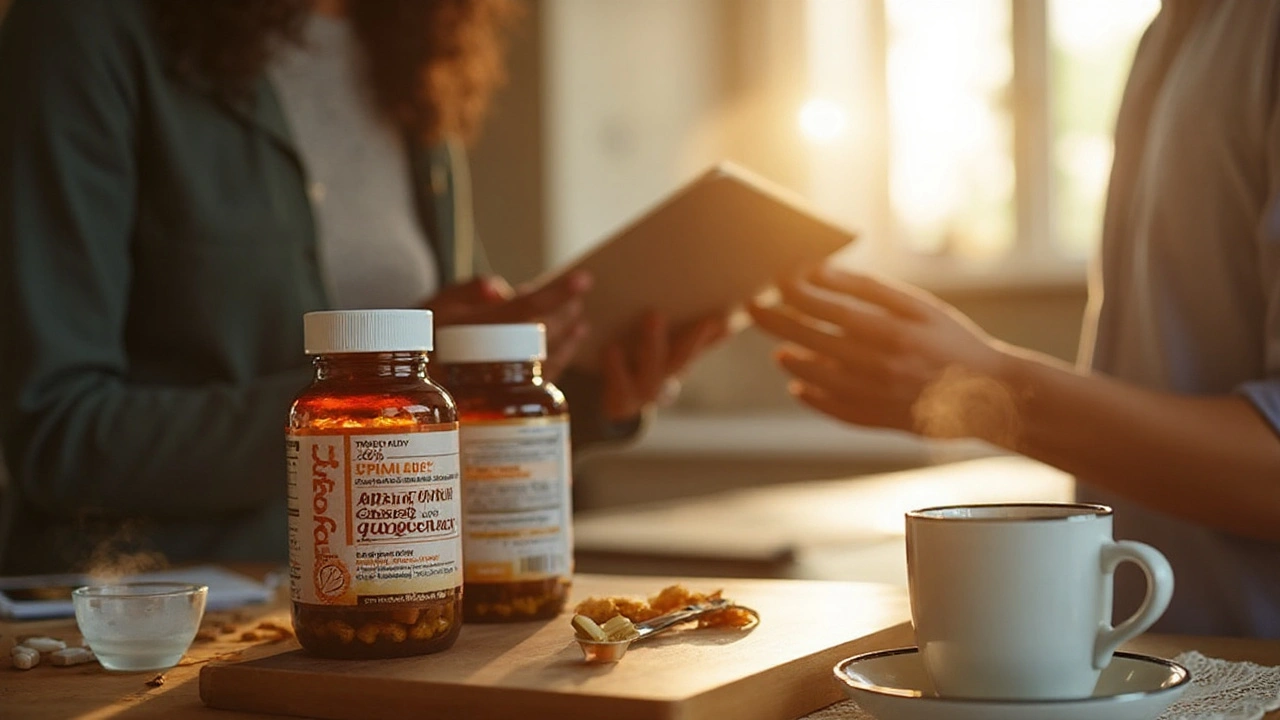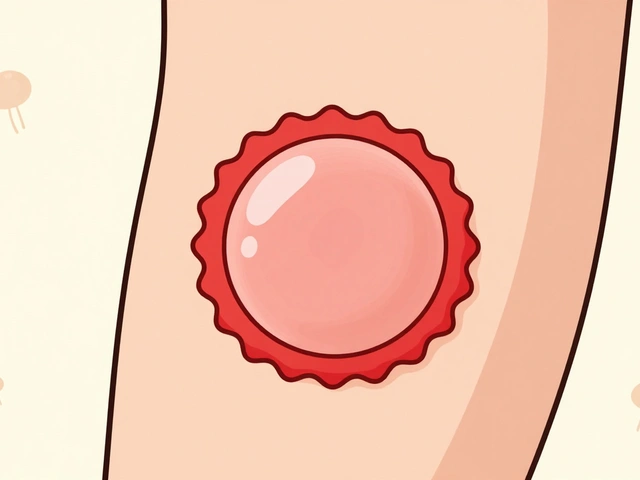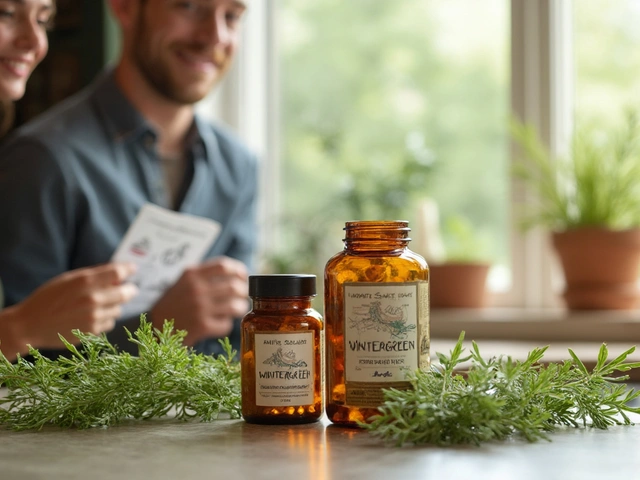You want more steady energy, better stress control, and maybe a nudge for blood sugar-without living on coffee or chasing hype. That’s the promise people pin on American ginseng. It’s trending hard again in 2025, but it’s not magic. Used right, it delivers modest, real wins for certain goals; used wrong, it’s a waste of money or a headache-literally. I’ll keep this simple, practical, and rooted in solid research and real-world use at my kitchen table (where Emily has watched me test far too many teas and capsules).
TL;DR and smart start
American ginseng (Panax quinquefolius) is a North American adaptogenic root with a calmer profile than Asian ginseng. Here’s the short version.
- What it can help: steady energy and stress resilience; small improvements in attention; modest support for post-meal blood sugar; some immune support in cold season. Expect subtle, not dramatic, effects.
- How to use: standardized extract 200-400 mg/day (3-5% total ginsenosides) in the morning; or 1-2 g/day of dried root. For post-meal glucose, take 30-60 minutes before the carb-heavy meal.
- Safety basics: avoid if pregnant, nursing, or under 18 without medical advice. Talk to your clinician if you use blood thinners (e.g., warfarin), diabetes meds/insulin, MAOIs, or have hormone-sensitive cancers. Watch caffeine-can cause jitters/insomnia.
- Quality: look for “Panax quinquefolius,” ginsenoside standardization, and third‑party seals (USP, NSF, Informed Choice). Skip mystery “proprietary blends.”
- Timeline: energy/stress benefits often within 1-2 weeks; blood sugar and immune outcomes need 4-8+ weeks. Cycle 8-12 weeks on, 2-4 weeks off.
What the research says in 2025 (quick hits):
- Blood sugar: Multiple randomized trials led by researchers in Toronto (e.g., Diabetes Care, 2000-2010) found American ginseng taken before meals blunted postprandial glucose; effects are modest but consistent.
- Fatigue: A Mayo Clinic-led RCT (Journal of the National Cancer Institute, 2013) reported reduced cancer-related fatigue with 2,000 mg/day of American ginseng vs placebo.
- Colds: Extracts of North American ginseng (like CVT‑E002) lowered the risk or duration of common colds in older adults in several trials (CMAJ, 2005; Respiratory Medicine, 2011), but not every study agrees.
- Cognition: Small, short-term studies show minor boosts to working memory/attention; the evidence is early and not uniform (NCCIH summaries, 2024).
Before you scroll: what you likely want to accomplish after clicking this page-pick the right form, find a safe dose, avoid side effects or interactions, know what results are realistic, and buy a product that isn’t junk. The rest of this guide is built around those jobs.
| Feature | American Ginseng (Panax quinquefolius) | Asian Ginseng (Panax ginseng) |
|---|---|---|
| Typical feel | Calmer, steadying; less stimulating | More stimulating; can feel like a soft boost |
| Main ginsenosides | Higher Rb1/Rb2 (more calming) | Higher Rg1/Re (more stimulating) |
| Common goals | Stress resilience, post-meal glucose, gentle energy | Energy, exercise performance, alertness |
| Typical daily dose | 200-400 mg extract (3-5% total ginsenosides) or 1-2 g root | 200-400 mg extract (3-7% total ginsenosides) or 1-2 g root |
| Best time | Morning; 30-60 min pre‑meal for glucose goals | Morning/noon; avoid late evening to prevent insomnia |
| Evidence snapshots | Glucose RCTs (Diabetes Care, 2000-2010); fatigue RCT (JNCI, 2013); cold season trials | More data on physical performance and fatigue (varied quality) |
| Key cautions | Interactions: warfarin, diabetes meds/insulin | Interactions: stimulants, some antidepressants |

How to use American ginseng safely and effectively
Here’s the playbook I wish I’d had when I started.
- Pick your goal. Choose one: steady energy and stress, better attention at work, support for post‑meal glucose, or immune support in cold season. Single-goal trials are easier to judge.
- Choose form and dose.
- Extract capsules: 200-400 mg/day standardized to 3-5% total ginsenosides is the sweet spot for most adults.
- Dried root slices/powder: 1-2 g/day in tea or food if you prefer whole-food style.
- Tea: simmer 1-2 g in water for 15-20 minutes; drink in the morning.
- Tincture: 1-2 mL of a 1:3 tincture up to twice daily; match label equivalence to grams of root.
- Time it right.
- Energy/stress: take with breakfast. If sensitive to herbs, start after food.
- Post‑meal glucose: 30-60 minutes before the meal that spikes you most.
- Immune season: daily for 8-12 weeks, then 2-4 weeks off.
- Cycle and adjust. Run 8-12 weeks. If you stop feeling it, take 2-4 weeks off to reset sensitivity.
- Track something objective. Energy 1-10 score by noon, 2-3 days/week. If glucose is the goal, use a glucometer or CGM notes around the same meal.
Goal-based dosing quick picks:
- Stress/steady energy: 200 mg extract with breakfast. If you need more, go to 300-400 mg after a week.
- Focus at work: 200 mg 60-90 minutes before a demanding block. Don’t stack with high caffeine the first week.
- Post‑meal glucose: 200-300 mg 30-60 minutes pre‑meal. Pair with fiber and protein for a compounding effect.
- Cold season support: follow the label of a standardized North American ginseng extract that has been studied; stick to 8-12 weeks.
Quality and label reading in 60 seconds:
- Botanical name must read “Panax quinquefolius.” If it says Panax ginseng or Eleutherococcus senticosus (eleuthero), that’s a different plant.
- Standardization: look for total ginsenosides at 3-5% per serving. Avoid vague “equivalent to X grams” without ginsenoside content.
- Third‑party testing: USP, NSF, Informed Choice, or ConsumerLab certification helps. In 2025, these seals remain the most practical filter for purity and dose accuracy.
- Country of origin: American ginseng is grown in the US and Canada, with Wisconsin and Ontario as big hubs. The origin doesn’t guarantee quality, but traceability matters.
- Additives: skip heavy proprietary blends, unnecessary sweeteners, or “energy matrixes” with hidden caffeine.
Safety first-who should pause or avoid:
- Blood thinners: American ginseng can reduce warfarin’s effect. If you use warfarin or other anticoagulants/antiplatelets, talk to your prescriber and monitor INR as advised.
- Diabetes meds/insulin: it can nudge glucose down. Monitor for lows as you start or adjust dose.
- Blood pressure and stimulants: combined with high caffeine, it can cause palpitations or insomnia.
- Hormone-sensitive conditions: if you have a history of hormone‑sensitive cancers, get a clinician’s guidance first.
- Pregnancy, nursing, kids: skip unless your clinician says otherwise.
Side effects and how to dodge them:
- Headache or jittery: lower the dose, take with food, or move earlier in the day. Cut caffeine.
- Stomach upset: switch from tincture to capsules or tea; start at half dose.
- Insomnia: no afternoon/evening dosing. If it persists, this herb may not fit you.
- Skin reactions: rare, but stop and check with a clinician if you see hives or rashes.
Decision tree (keep it simple):
- Do you want a calm, steady lift and you’re sensitive to stimulants? Choose American over Asian ginseng.
- Are you chasing pre‑meal glucose support? Time it 30-60 minutes before the target meal; start 200 mg extract.
- Are you already on caffeine? Start at the low end (200 mg) and don’t change your coffee for a week so you can isolate the effect.
- Is your main issue afternoon crash? Split the dose: 150-200 mg with breakfast, 150-200 mg at lunch. Never after 3 p.m. if you’re sleep‑sensitive.
Simple checklist before you buy:
- Panax quinquefolius on the label.
- 3-5% total ginsenosides per serving, clearly stated.
- Third‑party tested (USP/NSF/Informed Choice/ConsumerLab).
- Transparent dose (no proprietary blends).
- Reasonable price: in 2025, quality 200-400 mg/day products typically cost mid‑range; extreme bargains are often under‑dosed.
Real‑life example: I travel badly. Before long flights, I brew a mild tea with 1-1.5 g of dried American ginseng in the morning for a steady, calm day. Emily rolls her eyes until we land and I’m less wrecked than usual. That calm profile is why I reach for this species instead of the more stimulating Asian cousin.

FAQs, pitfalls, and next steps
Mini‑FAQ
- Is it a stimulant? Not like caffeine. American ginseng trends calmer. You might feel smoother focus more than a “buzz.”
- How long until I notice something? Many people feel steadier energy in 7-14 days. Glucose and immune outcomes need 4-8 weeks of consistent use.
- Can I take it every day? Yes, for 8-12 weeks, then take 2-4 weeks off. Cycling helps maintain effect and is common practice in herbalism.
- Can I stack it with coffee? Yes, but start low on both. If you get jittery, reduce caffeine first.
- Will it help with sleep? Not directly. Some people sleep better because daytime stress eases, but late dosing can keep you up.
- Does it raise blood pressure? Typically no; the American species is milder. But if you feel palpitations, reassess dose and caffeine.
- Is it safe for athletes and drug tests? Ginseng isn’t on WADA’s prohibited list. Still, use third‑party tested products to avoid contamination.
- What about colds? Some trials with North American ginseng extracts reduced colds or shortened duration, especially in older adults. It’s not a guarantee, but it’s reasonable to try during cold season.
- Can I use it if I’m on metformin or insulin? Possibly, with care. Monitor sugars closely and talk to your diabetes clinician to avoid lows.
- Any differences between Wisconsin and Canadian ginseng? Both can be excellent. Potency depends more on growing/processing and ginsenoside content than the border.
Common pitfalls to avoid
- Buying the wrong species. “Panax ginseng” is Asian ginseng. You want “Panax quinquefolius.”
- Chasing huge ginsenoside numbers. Beyond 5-7%, you may be paying for marketing, not better outcomes.
- Taking it at night. If you struggle with sleep, keep it to morning and lunch at the latest.
- Starting three new supplements at once. If you feel off, you won’t know what caused it. Change one thing at a time.
- Ignoring interactions. If you’re on warfarin, insulin, or sulfonylureas, involve your clinician.
Next steps by scenario
- Desk‑bound professional with afternoon crash: Start 200 mg extract with breakfast for one week. If crash persists, add 150-200 mg with lunch. Keep coffee to 1 cup before noon. Reassess in two weeks.
- Prediabetes or post‑meal spikes: Pick one target meal. Add 200-300 mg 30-60 minutes before that meal. Pair with 10-15 g fiber (veggies or psyllium) and a 10‑minute walk. Track glucose for 2 weeks; adjust only if trending high.
- Cold season planner: Choose a standardized North American ginseng extract used in trials; run it daily for 8-12 weeks, then 2-4 weeks off. Combine with sleep, hand hygiene, and vitamin D if you’re low.
- Focus without jitters: Use 200 mg 60-90 minutes before deep work. Skip energy drinks. If you still feel wired, this herb may not fit you-don’t force it.
Troubleshooting
- No effect after 3 weeks: Verify label (species, ginsenosides), move dosing to morning, and check caffeine/sleep. If it’s still flat, this may not be your herb.
- Jitters or headaches: Halve the dose or switch to tea/whole root. Space it away from coffee. Hydrate.
- Glucose lows: If you’re on diabetes meds, log readings and contact your clinician to adjust meds safely.
- Stomach upset: Take with food or change form (capsule → tea). Consider 1-2 g whole root instead of extract.
Credibility notes (so you know I’m not winging it): for blood sugar, see randomized trials by Vuksan and colleagues in Diabetes Care (2000-2010). For fatigue, see the Mayo Clinic-led trial in the Journal of the National Cancer Institute (2013). Cold season data comes from trials in CMAJ (2005) and Respiratory Medicine (2011) using North American ginseng extracts. Broad safety summaries are maintained by the National Center for Complementary and Integrative Health (updated 2024). Supplements in the U.S. are regulated under DSHEA; products do not treat or cure disease, and quality varies-hence the push for USP/NSF seals.
If you keep your goal narrow, your dose modest, and your quality bar high, American ginseng can be a quiet workhorse in your routine-no hype needed.







Kaylee Crosby
September 1, 2025 AT 07:46Just started taking 200mg of American ginseng with breakfast after reading this and honestly? My afternoon crash is way less brutal. No jitters, no coffee dependency. I’ve been tracking my energy on a 1-10 scale and it’s consistently 7-8 by 3pm now. Also took it before a big pasta dinner and my glucose monitor didn’t spike like usual. This isn’t magic but it’s real.
Start low, stay consistent, and don’t mix it with 3 espressos. You’ll thank me later.
Valérie Siébert
September 2, 2025 AT 11:31OMG YES I’M LIVING FOR THIS. I was gonna buy some Asian ginseng bc it looked ‘more powerful’ but thank u for the breakdown. American ginseng is like the chill older sister who shows up with tea and a hug not a hypebeast energy drink. I’ve been taking 1.5g dried root in my morning matcha and my brain feels like it finally stopped running on 2008 wifi. Also I’m not dying after flights anymore. 🙌
Terry Bell
September 4, 2025 AT 05:30I’ve been cycling this for 6 months now. 12 weeks on, 3 off. The first time I tried it I thought it was placebo but then I noticed I stopped reaching for that 4pm candy bar. My stress levels dropped. I sleep better. Not because it’s a sedative but because my nervous system isn’t screaming all day. It’s not a fix-all but it’s one of those quiet little tools that makes the rest of your habits work better. Honestly? If you’re tired of chasing stimulants, this might be your reset button.
Also side note: the Wisconsin root I got from a local herb shop had way better flavor than the Canadian one I tried. Taste matters more than you think.
Karen Ryan
September 5, 2025 AT 06:50Just wanted to say thank you for the label reading tips 💯 I used to buy ‘ginseng blends’ thinking they were premium. Now I only look for Panax quinquefolius + USP seal. I even showed my mom how to read labels and she bought her first quality supplement ever. She’s 72 and says she feels ‘more like herself’ 🥹
Caroline Marchetta
September 5, 2025 AT 12:38How delightful. Another wellness influencer telling us to spend $40 on a root that might, possibly, slightly reduce our post-lunch slump while we’re already on metformin and warfarin. Truly, the pinnacle of modern self-care. I’ll just keep drinking coffee and ignoring the fact that my doctor warned me about herb-drug interactions. Because why not? The FDA doesn’t regulate this stuff anyway. 😌
Jacqueline Aslet
September 7, 2025 AT 03:22One must question the epistemological foundations of adaptogenic supplementation in an era saturated with commodified biohacking. The very notion that a phytochemical compound, extracted from a subterranean organ cultivated under specific pedological conditions, can modulate human neuroendocrine response with clinical precision, betrays a fundamental ontological misunderstanding of homeostasis. One might as well pray to a quartz crystal. The placebo effect is statistically robust, and the market for such substances is a mirror of late-stage capitalist anxiety. I remain skeptical. And yet… I have a jar on my shelf. Curious, isn’t it?
Adesokan Ayodeji
September 8, 2025 AT 15:21Man this is the best guide I’ve read on ginseng so far! I’m from Nigeria and we use herbs all the time but never knew American ginseng was different from Asian. I tried it after my cousin told me about it and honestly, my energy stayed steady during long workdays without me needing to nap. I take it with my morning pap and it’s like my body finally stopped feeling like it’s running on a dying battery. Also, I told three of my friends and they all bought it too. Quality matters, like you said-don’t fall for cheap blends. I got mine from a Canadian supplier with NSF seal and it’s been smooth sailing. Keep sharing this kind of real talk.
God bless.
Lawrence Zawahri
September 9, 2025 AT 09:09THIS IS A SMOKE SCREEN. American ginseng? They’re using it to manipulate your blood sugar so you don’t notice the glyphosate in your food. The FDA, Big Pharma, and the Canadian government are all in on this. Why do you think they’re pushing ‘standardized extracts’? So they can patent the damn root and charge you $50 a bottle. Look at the timeline-2000-2010 trials? That’s when they started pushing the narrative. And now they want you to ‘cycle’ it like it’s a drug? It’s a trap. They want you dependent on their ‘quality’ products. Real health is in wild foraging, not third-party seals. Wake up.
Rachelle Baxter
September 9, 2025 AT 10:37I appreciate the effort but you completely ignored the fact that ginseng is often contaminated with lead and pesticides. You mention USP seals but you don’t say how often those labs fail to catch toxins. Also, you didn’t mention that 40% of supplements labeled ‘American ginseng’ are actually mislabeled Asian ginseng. And you call it ‘modest’ improvement? That’s a dangerous understatement. People with diabetes could go into hypoglycemia and die because you didn’t emphasize monitoring enough. This isn’t ‘quiet workhorse’-it’s a liability. I’ve seen ER reports. You should be held accountable.
Benjamin Gundermann
September 9, 2025 AT 12:03Look I’m all for natural stuff but this is just another way for rich people to feel superior while ignoring real solutions. You’re telling folks to spend $40 on a root because their job is stressful? Bro. Get a better job. Stop drinking coffee. Sleep more. Walk outside. American ginseng is just a fancy placebo for people who don’t want to change their lifestyle. And don’t even get me started on ‘cycling’-sounds like they’re trying to turn herbalism into a subscription service. Meanwhile, the real problem is our 12-hour workdays and zero mental health support. But nah, let’s just pop a pill and call it wellness. 🇺🇸
Terry Bell
September 9, 2025 AT 17:46Man I read your comment about the FDA and I just laughed. You think they’re hiding the truth? Then why is American ginseng still sold in Walmart next to gummy vitamins? If it was dangerous they’d pull it. I’ve been using it for years and I’ve never had a problem. I think you’re just mad because you don’t want to admit that sometimes small changes DO help. I’m not rich, I’m just tired of feeling like crap every day. This herb helped me. That’s all I know.
And yeah, I work 10 hours too. But I also take walks. And sleep. And this. It’s not either/or. It’s both.